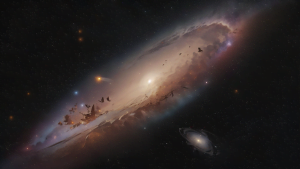Exploring the Enigmatic Globular Clusters of the Andromeda Galaxy
3 min read
Andromeda News
The Andromeda Galaxy, also known as Messier 31 or M31, is a magnificent spiral galaxy located approximately 2.537 million light-years away from Earth. As one of the closest neighboring galaxies to our Milky Way, it has captivated astronomers and stargazers alike for centuries. In this highly specific article, we will delve into the intriguing realm of Andromeda’s globular clusters, highlighting their unique characteristics and shedding light on the mysteries they hold.
A Plethora of Stellar Clusters:
Globular clusters are densely packed groups of ancient stars that orbit around the core of a galaxy. Andromeda is home to an impressive number of these celestial marvels, boasting over 400 known globular clusters. These clusters provide valuable insights into the formation and evolution of galaxies, including our own.
Unraveling Their Age and Composition:
Studying the globular clusters of Andromeda allows astronomers to estimate the age of the galaxy and gain a deeper understanding of its stellar populations. Through spectroscopic analysis, researchers can decipher the composition of these clusters, providing clues about the chemical enrichment processes that occurred billions of years ago.
Stellar Dynamics and Dark Matter:
Globular clusters within Andromeda are not only rich in stars but also harbor secrets about the nature of dark matter. By observing the motions of stars within these clusters, scientists can study their dynamics and determine the gravitational forces at play. These measurements contribute to our understanding of dark matter distribution within galaxies.
The Halo Population:
Andromeda’s globular clusters are found not only within its galactic disk but also in its extended halo region. This population of globular clusters, spanning great distances from the core, offers valuable information about the galaxy’s assembly history, interactions with smaller satellite galaxies, and the overall structure of Andromeda itself.
Formation and Merger History:
Through the study of globular clusters, astronomers can uncover crucial details about the formation and merger history of the Andromeda Galaxy. The distribution, ages, and chemical compositions of these clusters provide important clues to the series of events that shaped the galaxy into what we observe today.
Variable Stars and Stellar Evolution:
Globular clusters in the Andromeda Galaxy contain a variety of variable stars, including RR Lyrae and Cepheid variables. By studying the pulsations and brightness variations of these stars, astronomers can determine their intrinsic luminosity and use them as distance indicators, helping to refine our understanding of the size and structure of the universe.
Exoplanets in Globular Clusters:
While exoplanets are commonly associated with individual stars, recent research has suggested that globular clusters could also harbor their own planetary systems. The densely packed nature of these clusters creates a unique environment, raising intriguing questions about the potential existence of exoplanets within Andromeda’s globular clusters.
Stellar Collisions and Blue Stragglers:
The high stellar density within globular clusters can lead to close encounters and even stellar collisions. These interactions can give rise to unusual stellar objects known as blue stragglers. By studying these stars, astronomers gain insights into stellar evolution, binary star systems, and the dynamical processes occurring within globular clusters.
Future Collision with the Milky Way:
One of the most fascinating aspects of the Andromeda Galaxy is its impending collision with our Milky Way. In approximately 4 billion years, these two galaxies will merge, forever altering their structures. Globular clusters will play a crucial role in deciphering the history and effects of this galactic collision.
Advancements in Observational Techniques:
Studying Andromeda’s globular clusters pushes the boundaries of observational astronomy. With the development of powerful telescopes and advanced imaging techniques, astronomers can capture detailed images, spectra, and data from these clusters. These technological advancements continue to expand our knowledge of the Andromeda Galaxy and the wider universe.
The exploration of Andromeda’s globular clusters encompasses a wide range of fascinating topics, from stellar dynamics and dark matter to exoplanets and the future collision with our own Milky Way. As our understanding of these celestial objects evolves, we gain valuable insights into the formation, evolution, and interconnectedness of galaxies. The study of Andromeda’s globular clusters will undoubtedly continue to inspire discoveries and expand our cosmic horizons.
The globular clusters of the Andromeda Galaxy represent a captivating realm of astronomical research. These stellar conglomerates offer valuable insights into the galaxy’s past, shedding light on its formation, evolution, and interactions with other celestial bodies. By delving into the highly specific study of Andromeda’s globular clusters, astronomers continue to unravel the mysteries of our vast universe and deepen our understanding of the cosmos.



